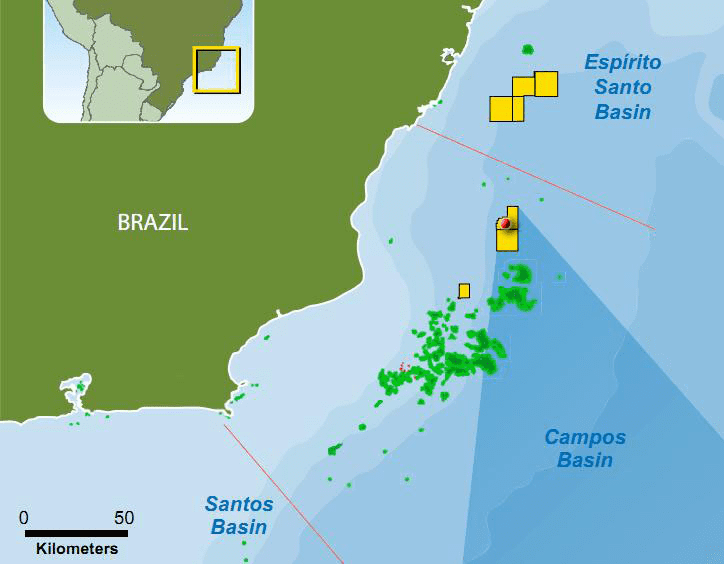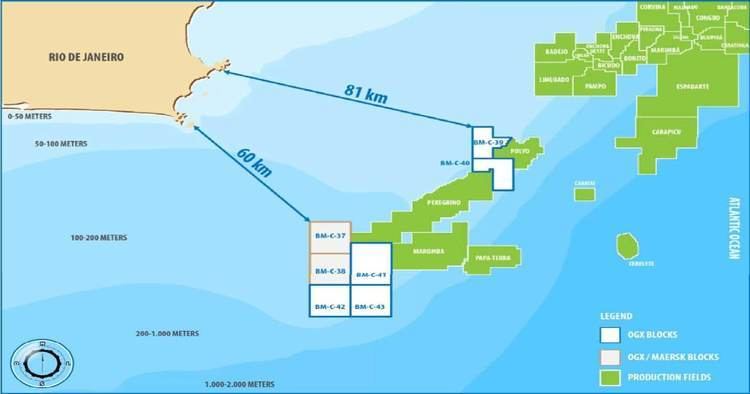 | ||
Campos basin
Campos Basin is one of 12 coastal sedimentary basins of Brazil. It spans both on-shore and off-shore parts and is located near Rio de Janeiro. The basin originated in Neocomian stage of the Cretaceous period 145–130 million years ago during the breakup of Gondwana. It has a total area of about 115,000 square kilometers whereas the on-shore portion is small at only 500 square kilometers.
Contents
Exploration
The off-shore oil exploration in the Campos Basin began in 1968. The first exploratory well was drilled in 1971. The first field to be discovered was Garoupa in 1974 at a shallow depth of 120 m followed by Namorado in 1975 in 166 m of water. The first oil production started in 1977 from Enchova field at the depth of 124 m. The largest fields (discovery year) include Linguado (1978), Carapeba (1982), Vermelho (1982), Marimba (1984), Albacora (1984), Marlim (1985), Albacora-Leste (1986), Marlim Sul (1987), Marlim Leste (1987), Barracuda (1989), Caratinga (1989), Espadarte (1994), Roncador (1996), Jubarte (2002) and Cachalote (2002). The largest Marlim field is located northeast of the Basin, 110 km offshore in water 650 to 1050 m deep.

By 2003 41 oil and gas fields had discovered, which lie at the distances 50 to 140 km from the cost and at water depths varying from 80 to 2,400 m. Of these fields 37 are being developed by Petrobras. By 2003 the oil production from the basin had reached 1.21 million barrels per day. The production comes from a variety of reservoirs including siliciclastic turbidites, fractured basalts, coquinas, calcarenites (limestones). The total cumulative production from the Campos Basin by 2003 was 3.9 billion barrels of oil with remaining reserves of 8.5 billion barrels.
In February 2010 a new 65 million barrel discovery was made by Petrobras near the Barracuda oil field.
Oil and gas production
Total daily production of Campos Basin is 265,000 cubic metres (1.69 million barrels) of oil and 26,8 million cubic metres of natural gas per day. The estimates are that in 2010, Campos Basin will be producing 282,000 cubic metres (1.8 million barrels) of oil and 34,6 million cubic metres of natural gas per day. Marlim complex produces over 80,000 cubic metres (500,000 barrels) of crude oil per day.

The confirmed reserves are 1.1 billion cubic metres (7.21 billion barrels) of oil and condensate, and 101.53 cubic kilometres of natural gas. Exploration seems to be fading; most reserves were found between 1985 and 1997.
Geology

The Campos basin is bounded on the south by the Cabo Frio arch and on the north by the Vitoria arch, and contains the Paraiba do Sul River delta. Oil reservoirs include the Aptian and pre-Aptian continental rift phase, in Albian-Cenomanian shallow-water marine carbonates and deepwater sandstones, and in turbidites of the open-marine deepwater phase of Late Cretaceous and early Tertiary ages.
The Namorado field "location was selected based on seismic interpretation of a structural high at the top of the Macae Formation (Albian limestones)" at a depth of about 3 km. and the reservoirs are marine turbidite deposits transgressing over the Albian limestone shelf.
The stratigraphy starts with 120 m.y. basalt flows, overlain by the Lagoa Feia Formation consisting of the organic-rich lacustrine "green shales" followed by lacustrine limestones and continental sandstones and conglomerates, transitioning into marine sediments with evaporites, limestones, and limestone altered dolomites. The shallow-water marine limestone Macae Formation follows, then the Namorado turbidite sandstones, and finally the Campos formation, consisting of the turbidite sandstone Carapebus Member and the prograding slope and shelf Ubatuba Formation.
